Savory, spicy, and packed with basil and beef flavor, that is what flashes across my mind when I think of Thai basil beef. It is a perfect one-pot meal, as it can be made in under 30 minutes and satisfies almost every palate.
The star of the dish is the irresistible flavor of fresh basil leaves. You will experience the aroma of basil wafting up immediately to permeate the entire kitchen as you cook.
Thai basil beef is so versatile that it can be served as noodles or rice, topped with a fried egg.
Let’s get into the details of making this beloved dish at home.
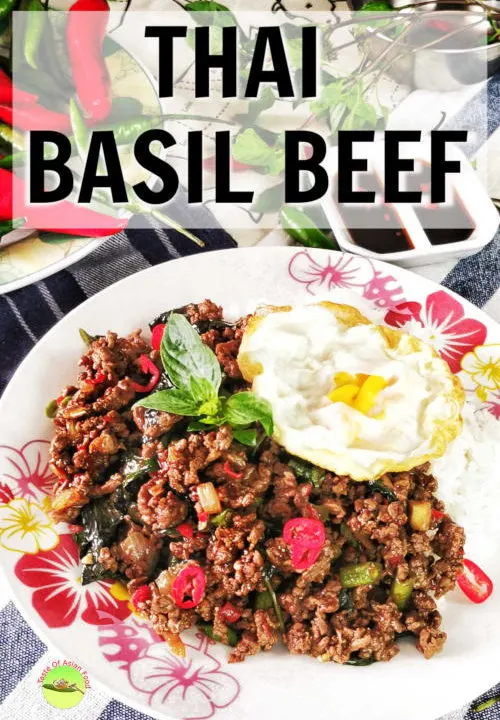
Note: This post may contain affiliate links. Please read my privacy policy for more info. I may receive commissions for purchases made through links in this post. As an Amazon Associate, I earn from qualifying purchases.
Main Ingredients for Preparing Thai Basil Beef
- Ground beef. The quickest way to prepare Pad Gra Pow is to use store-bought ground meat. Otherwise, you can choose your preferred cut of beef and mince it yourself. I recommend using chuck steak for its rich flavor and well-balanced meat-to-fat ratio. Round steak is also a good option. There’s no need to mince the beef too finely. I usually cut half-frozen beef chuck into thin slices, then into strips, and finally into small cubes. This method works perfectly for this Thai spicy basil beef recipe.
- Chilies. This recipe uses two types of chilies. The first are bird’s eye chilies, which are small, about one to two inches long, but very spicy. I use only three, but feel free to add more if you can handle the heat. Removing the seeds can be tricky since the chilies are small, and the seeds are usually left in the dish. I also include some large red Thai chilies, which are milder. They add extra chili flavor to the beef stir-fry. While bell peppers aren’t traditionally part of this recipe, they complement the flavors nicely. Diced red bell pepper can be used as a substitute for chopped red chili if you want to tone down the spiciness.
- Main seasonings. The Thai basil beef recipe (pad gra prow or pad krapow) utilizes the trinity combination for Thai cooking. (fish sauce, light soy sauce, and oyster sauce). There’s no need to add salt, as these ingredients are already salty. The quantities can be adjusted to suit your personal taste, but I generally use roughly equal portions of each. Please refer to the recipe below for the exact amounts I use.
- Other seasonings. Dark soy sauce is used mainly to deepen the color, making the dish look more appealing. I also add a bit of sugar to balance the flavor, as the other seasonings are quite salty.
- Long beans. Many Thai basil beef recipes also include long beans. They add a crunchy texture that contrasts nicely with the meaty beef, enhancing the overall mouthfeel of the dish. Long beans also introduce a pop of color, balancing out the monotonous brown appearance of the minced beef. Use green beans (French beans) if Asian long beans are unavailable.
- Basil. For the most authentic flavor, use Thai holy basil. It’s what gives Pad Kra Pao its signature taste. If you can’t find it, Thai basil is the next best alternative. Sweet basil (Italian basil) can also be used as a substitute.
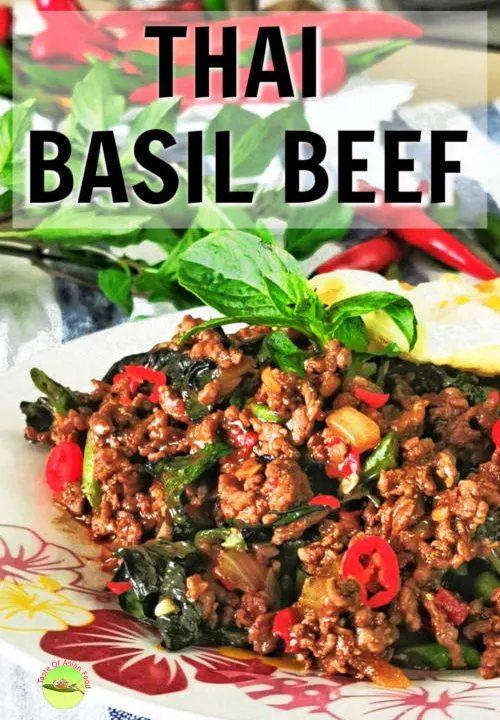
How to make Thai basil beef (pad gra prow)
This basil beef recipe is quick and easy. You can have it ready in under thirty minutes once your ingredients are prepped.
- Cut the long beans on the bias into pieces about 1 cm long, and cut the onion into small dice.
- Pre-mix the ingredients in Ingredients B in a small bowl. Add two tablespoons of water and stir well to dissolve the sugar. Doing this ensures you won’t miss any ingredients during stir-frying. If you’re confident, you can also add them separately to the wok while cooking.
- Grinding the garlic and chili with a mortar and pestle helps release their flavor, though the difference isn’t very significant compared to finely chopping them.
- Heat some oil in a wok or a large skillet. Add the ground garlic and chili to the oil and stir fry until aromatic, roughly taking about half to one minute over low to medium heat.
- Mix the minced beef with the garlic and chili. Keep stir-frying until the meat starts to cook and releases its juice.
- Remove the beef from the wok, then add some oil to stir-fry the long beans and onions for a minute or two until they soften. If the pan becomes too dry, you can add one to two tablespoons of water while stir-frying.
- Return the beef to the wok and combine with other ingredients over medium-high heat.
- Now, season the beef stir fry with the mixture of seasonings. Pour it into the beef and continue to stir fry. Most of the juices will become dry when the beef is fully cooked.
- Prepare a cornstarch slurry by combining 1 teaspoon of cornstarch and 2 tablespoons of cold water. Add it to the beef and give it a few quick stirs. The cornstarch will immediately thicken the sauce, making it ideal to cling to the noodles and stick well to the rice.
- Mix the basil leaves into the minced beef and give it a few quick flips and stirs. Then turn off the heat to let the residual warmth gently wilt the basil leaves. And yes, your Thai basil beef is ready!
Note:
- When adding one cup of basil leaves to the beef, it may look like a lot, but the leaves will wilt and hardly add any volume to the final dish.
- It is advisable to stir-fry the beef and the long beans separately. Long beans need a longer time to cook until soft, so you will overcook the beef if you stir-fry the beans with the meat.
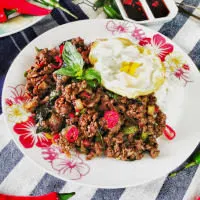
Thai basil beef
Savory, spicy, and packed with the flavor of basil and fish sauce, that is what flashes across my mind when I think of Thai basil beef.
Thai basil beef is so versatile that it can be served as Thai basil beef noodles or Thai basil beef bowl top with a fried egg.
Ingredients
Ingredients A- to grind
- 8 cloves garlic
- 3 bird’s eye chili
- 3 large red chili, remove seeds
Ingredients B- Seasonings
- 1.5 tbsp light soy sauce
- 1.5 tbsp oyster sauce
- 1 tbsp fish sauce
- 2 tsp dark soy sauce
- 2 tsp sugar
- 2 tbsp water
Ingredients C
- 500g ground beef
- 3/4 cup long bean, cut on the bias, 1cm length
- I medium-size onion, cut into small dices
- 1.5 cup basil leaves
- 1 tsp cornstarch (make a slurry with 2 tbsp of water)
- 1 egg
Instructions
- Grind ingredients A with the mortar and pestle.
- Heat some oil in a wok. Add the grind garlic and chili to the oil and stir fry until aromatic.
- Add the minced beef to the garlic and chili. Keep stir-frying until the meat starts to cook and releases its juice. Then, remove it from the wok.
- Add some oil to the wok to stir-frying the long beans and onion for a minute or two until they turn soft.
- Return the beef to the wok and combine with other ingredients.
- Add the seasonings (Ingredients B).
- Pour the cornstarch slurry into the wok and give it a few quick stirs.
- Add the basil leaves. Mix and turn off the heat.
- Fry an egg with 4 tbsp of oil until the edges turn golden and with blisters.
- Serve the basil beef with steamed rice or noodles, top with the egg, and garnish with more fresh basil leaves and chopped red chilies.
Recommended Products
As an Amazon Associate and member of other affiliate programs, I earn from qualifying purchases.
-
 ChefSofi Mortar and Pestle Set - 6 Inch - 2 Cup Capacity - Unpolished Heavy Granite for Enhanced Performance and Organic Appearance - INCLUDED: Anti-Scratch Protector + Italian Recipes EBook
ChefSofi Mortar and Pestle Set - 6 Inch - 2 Cup Capacity - Unpolished Heavy Granite for Enhanced Performance and Organic Appearance - INCLUDED: Anti-Scratch Protector + Italian Recipes EBook -
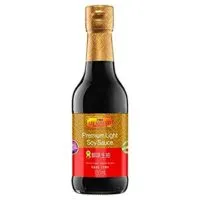 Lee Kum Kee Premium Light Soy Sauce - 150ml (5.27 fl oz)
Lee Kum Kee Premium Light Soy Sauce - 150ml (5.27 fl oz) -
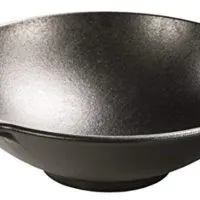 Lodge 14 Inch Cast Iron Wok. Pre-Seasoned Wok with Flattened Bottom for Asian Stir Fry and Sautees
Lodge 14 Inch Cast Iron Wok. Pre-Seasoned Wok with Flattened Bottom for Asian Stir Fry and Sautees -
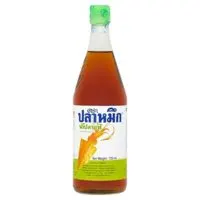 Squid Fish Sauce 725ml
Squid Fish Sauce 725ml
Nutrition Information:
Yield: 3 Serving Size: 1Amount Per Serving: Calories: 1722Total Fat: 99gSaturated Fat: 33gTrans Fat: 1gUnsaturated Fat: 43gCholesterol: 412mgSodium: 5580mgCarbohydrates: 80gFiber: 9gSugar: 15gProtein: 126g
This data was provided and calculated by Nutritionix on 6/19/2021
Bonus step: Fry an egg, Thai-style
Thai basil beef with rice tastes even better when topped with an egg. This egg is cooked somewhere between a pan-fry and a deep-fry, creating a texture quite different from most Western-style fried eggs, where browning the edges is often seen as less desirable.
Here is how to prepare the fried egg:
- Add three to four tablespoons of oil to the wok. Wait until the oil is hot and starts to smoke.
- Place an egg gently into the oil. The egg will start to form bubbly, crispy edges.
- Gently push the egg with the spatula if the egg starts to stick to the bottom. Do not turn the egg over! The air pocket inside the egg white will expand and form large blisters, and sometimes expand so much that it looks like a choux pastry! Eventually, they will break and divide. Once you see the edges are golden, remove it and drain the oil.
The Thai basil beef is best served on a bed of Jasmine rice and topped with Thai-style fried eggs. Add some sweet chili sauce and a squeeze of fresh lime juice for extra flavor if you like. It is also best to serve with any noodles.
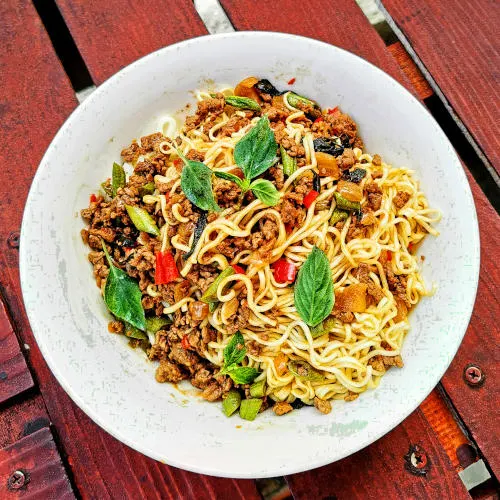
Related recipes to pad gra prow
If you enjoy this Thai basil beef stir-fry, I encourage you to explore other Thai dishes featured on this blog. Here are some of my favorites:
- Tom yum soup looks deceptively unpretentious but has a bold, citrusy, and savory flavor. You will feel the bursting taste of the fresh Thai herbs with a pop of spicy heat lingering in your mouth.
- Pad see ew is a Thai-style stir-fried noodle with soy sauce. Here is the detailed instruction on how to prepare it.
- Pandan leaf chicken is one of the best specialty chicken dishes in Thailand. The chicken is moist, tender, infused with a refreshing pandan aroma, and encased in leaf packets. The taste is worth hunting down to get pandan leaves if you live outside Asia, usually at Asian grocery stores.
- Try this Thai Basil Chicken if you do not eat beef. It is one of my favorite Thai dishes.

david
Friday 29th of August 2025
how long should this cook for ? cos there is no indication inn the recipe.
KP Kwan
Sunday 31st of August 2025
Keep stir-frying until the minced beef begins to brown and release its juices. This usually takes about 2–5 minutes over medium heat.
DONNA L
Friday 29th of August 2025
Hi KP I made this Thai Basil Beef. I can't tell you how good it was and easy to make. The way the recipe was split in the preparation of the seasonings, etc. was very helpful. I did tweak the recipe slightly by adding more of the chili peppers as my family likes their Thai food slightly spicier than most. But again, THANK YOU FOR THIS RECIPE!
KP Kwan
Friday 29th of August 2025
So glad you enjoyed it! Wishing you all the best!
Brad
Monday 4th of August 2025
Made this for lunch today. Very beautiful.
Thanks
KP Kwan
Tuesday 5th of August 2025
So happy you enjoyed it!
Michele
Sunday 27th of June 2021
Hi, I love your recipe and would love to make it, but I hate oyster sauce. Is there anything I can use instead?
Thanks
KP Kwan
Sunday 27th of June 2021
Hi Michele, You can substitute oyster sauce with light soy sauce, plus just a bit of sugar. Thanks, KP Kwan
KP Kwan
Saturday 19th of June 2021
Hi, this is KP Kwan. I am happy to see you in this comment area as you have read through my recipe. I am pleased to reply to any questions and comments as soon as possible.